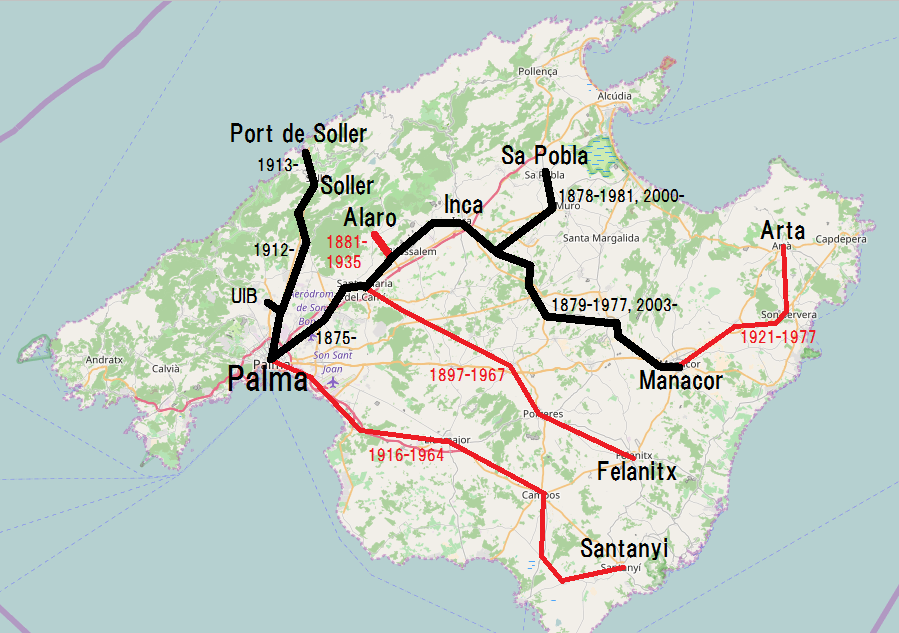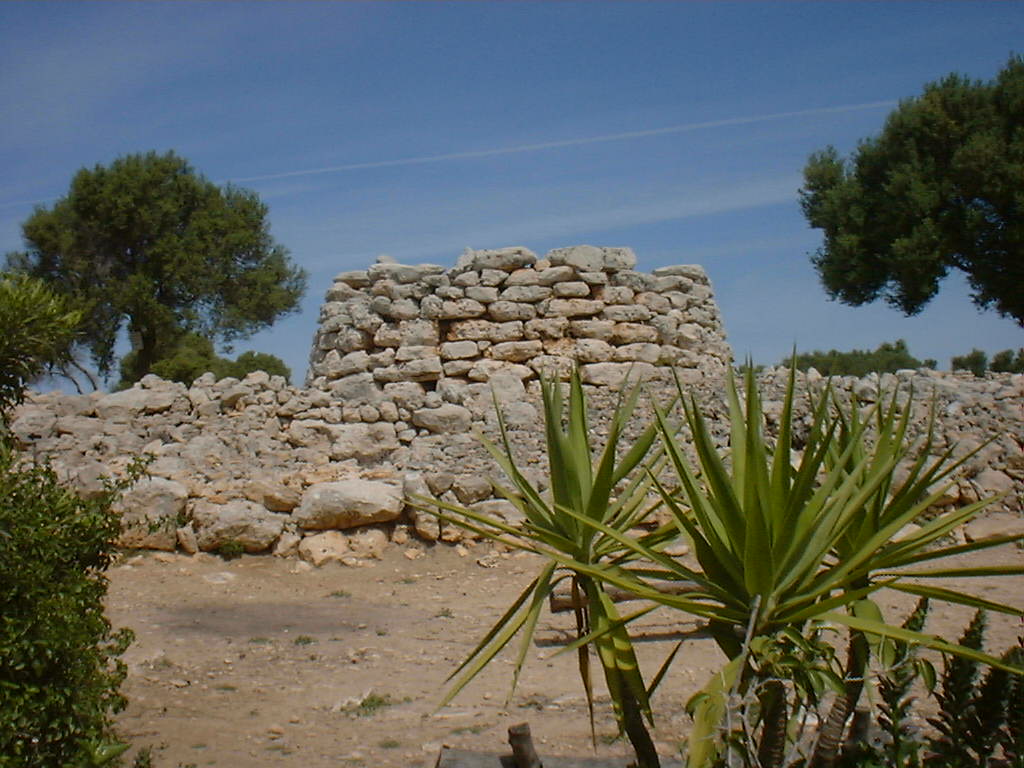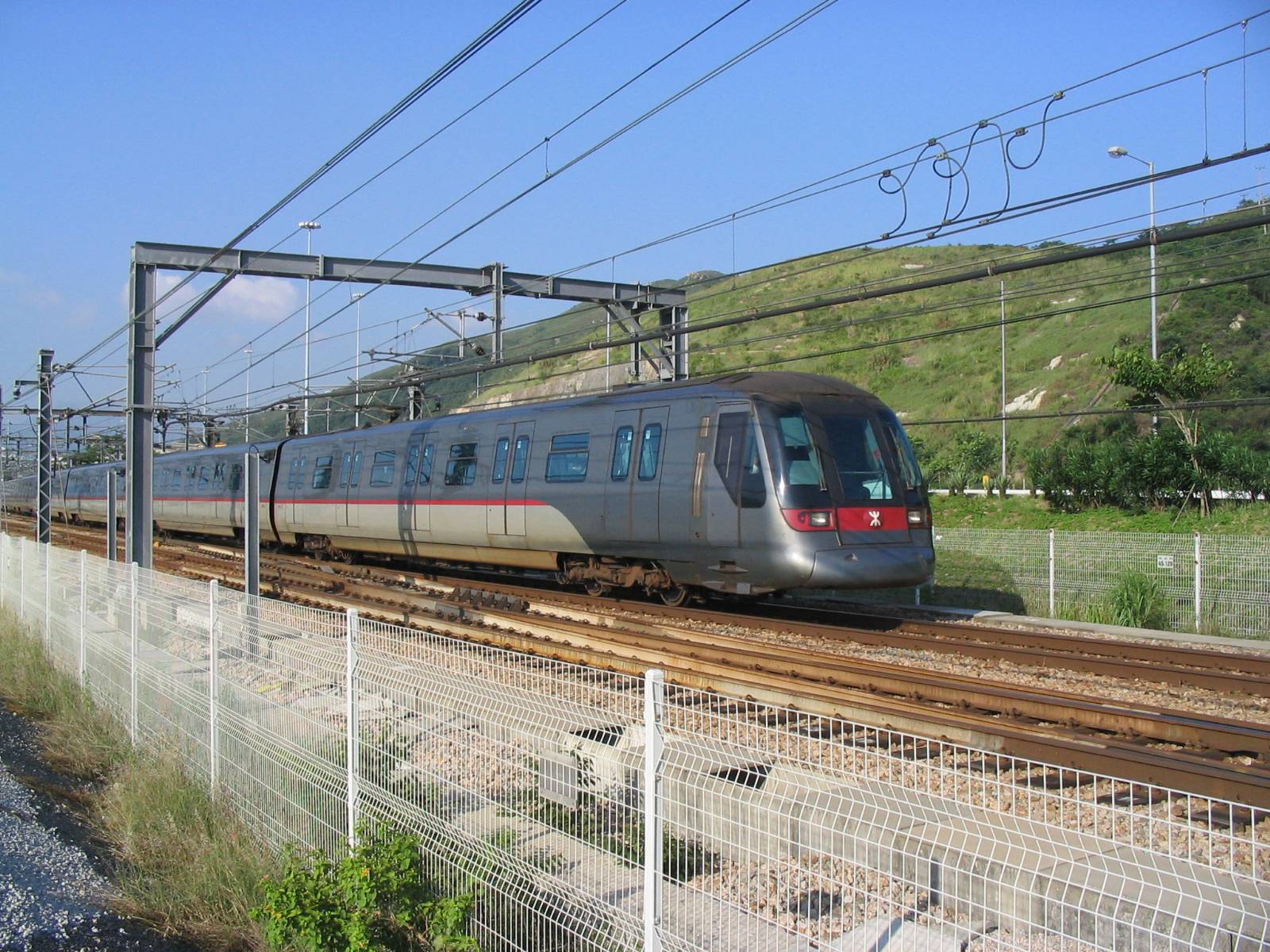|
Serveis Ferroviaris De Mallorca
Serveis Ferroviaris de Mallorca () or SFM is a company which operates the metre gauge railway network on the Spanish island of Majorca. The total length, including Palma Metro, also operated by this company, is . Overview In 1977, the line Palma – Inca was the sole remnant of a network that once connected Palma with most of the island. In 2001, the section Inca – Sa Pobla reopened, followed by the section Inca – Sineu in 2002 and Sineu – Manacor in 2003. The expected extension of the branch line from Sa Pobla onwards to Alcúdia in 2005 has yet to be built. The line from Manacor to Artà was under construction for a planned 2012 reopening. The project was halted in 2013 (with most of the groundwork completed) and an announcement made that the route instead was to be converted "for the time being") to a '' via verde'' for cyclists and walkers. Electrification €30m was invested in electrifying the whole line, from Palma to Inca, at 1.5 kV DC, which was completed ... [...More Info...] [...Related Items...] OR: [Wikipedia] [Google] [Baidu] |
Majorca
Mallorca, or Majorca, is the largest of the Balearic Islands, which are part of Spain, and the List of islands in the Mediterranean#By area, seventh largest island in the Mediterranean Sea. The capital of the island, Palma, Majorca, Palma, is also the capital of the autonomous communities of Spain, autonomous community of the Balearic Islands. The Balearic Islands have been an autonomous region of Spain since 1983. There are two small islands off the coast of Mallorca: Cabrera, Balearic Islands, Cabrera (southeast of Palma) and Dragonera (west of Palma). The anthem of Mallorca is "La Balanguera". Like the other Balearic Islands of Menorca, Ibiza, and Formentera, the island is a highly popular holiday destination, particularly for tourists from the Netherlands, Republic of Ireland, Ireland, Germany, and the United Kingdom. The international airport, Palma de Mallorca Airport, is one of the busiest in Spain; it was used by 28 million passengers in 2017, with use increasing ever ... [...More Info...] [...Related Items...] OR: [Wikipedia] [Google] [Baidu] |
Construcciones Y Auxiliar De Ferrocarriles
Construcciones y Auxiliar de Ferrocarriles (Grupo CAF, ) is a Spanish publicly listed company which manufactures railway vehicles and equipment and buses through its Solaris Bus & Coach subsidiary. It is based in Beasain, Basque Autonomous Community, Spain. Equipment manufactured by Grupo CAF includes light rail vehicles, rapid transit trains, railroad cars and locomotives, as well as variable gauge axles that can be fitted on any existing truck or bogie. Over the 20 years from the early 1990s, CAF benefited from the rail investment boom in its home market in Spain to become a world player with a broad technical capability, able to manufacture almost any type of rail vehicle. CAF has supplied railway rolling stock to a number of major public transport, urban transit operators around Europe, the US, South America, East Asia, India, Australia and North Africa. History ''CAF'' was an acronym for the earlier name of ''Compañía Auxiliar de Ferrocarriles'', as well as for ''Constr ... [...More Info...] [...Related Items...] OR: [Wikipedia] [Google] [Baidu] |
Railway Companies Of Spain
Rail transport (also known as train transport) is a means of transport using wheeled vehicles running in tracks, which usually consist of two parallel steel rails. Rail transport is one of the two primary means of land transport, next to road transport. It is used for about 8% of passenger and freight transport globally, thanks to its energy efficiency and potentially high speed.Rolling stock on rails generally encounters lower frictional resistance than rubber-tyred road vehicles, allowing rail cars to be coupled into longer trains. Power is usually provided by diesel or electric locomotives. While railway transport is capital-intensive and less flexible than road transport, it can carry heavy loads of passengers and cargo with greater energy efficiency and safety. Precursors of railways driven by human or animal power have existed since antiquity, but modern rail transport began with the invention of the steam locomotive in the United Kingdom at the beginning of the 19th ... [...More Info...] [...Related Items...] OR: [Wikipedia] [Google] [Baidu] |
Rail Transport In The Balearic Islands
Rail or rails may refer to: Rail transport *Rail transport and related matters *Railway track or railway lines, the running surface of a railway Arts and media Film * ''Rails'' (film), a 1929 Italian film by Mario Camerini * ''Rail'' (1967 film), a film by Geoffrey Jones for British Transport Films * ''Rail'' (2024 film), a Tamil-language film Magazines * ''Rail'' (magazine), a British rail transport periodical * ''Rails'' (magazine), a former New Zealand based rail transport periodical Other arts *The Rails, a British folk-rock band * Rail (theater) or batten, a pipe from which lighting, scenery, or curtains are hung Technology *Rails framework or Ruby on Rails, a web application framework *Rail system (firearms), a mounting system for firearm attachments *Front engine dragster *Runway alignment indicator lights, a configuration of an approach lighting system *Rule Augmented Interconnect Layout, a specification for expressing guidelines for printed circuit boards; companion ... [...More Info...] [...Related Items...] OR: [Wikipedia] [Google] [Baidu] |
Tranvía De Sóller
The Tranvía was a tram, streetcar system that served Manila and Metro Manila, its surrounding cities during the early years of the 20th century. History Prior to the tranvia, modes of street transportation in Manila were mostly horse-drawn, consisting of the ''Kalesa, calesa'', the lighter ''Wiktionary:carromata, carromata'', and the fancy . The tranvia served as the first railway transport to run in the Philippines, as in its earliest years the Philippine National Railways, Ferrocarril de Manila–Dagupan are in its planning stages. The tranvia was renowned as "state-of-the-art" in East Asia, and had provided efficient transport to the residents of Manila. ''Tranvias de Filipinas'' During the Spanish colonial era, the tramway was referred to as the ''Tranvias de Filipinas''. The decree in 1875 by King of Spain, King Alfonso XII of Spain, Alfonso XII initiated the planning for railways in the Philippines. The following year, in 1876, the , prepared by the Administracion d ... [...More Info...] [...Related Items...] OR: [Wikipedia] [Google] [Baidu] |
Transport In Spain
Transport in Spain is characterised by a network of roads, railways (including having high speed rail network that is the second longest in the world), trams, air routes, and ports. Its geographic location makes it an important link between Europe, Africa, and the Americas. Major forms of transit generally radiate from the capital, Madrid, located in the centre of the country, to link with the capitals of the autonomous communities. Spanish transit is marked by a high degree of integration between its long-distance railway system and inner-city metro systems, although the historic use of broad gauge has limited integration with its neighbours. Spain is currently working to increase and improve linkage with the rail systems of France and Portugal, including the high-speed rail line between Madrid and Lisbon. Spain's highway system is developed, with both tolled and free motorways. Air traffic is routed through several international and regional airports, the largest of which i ... [...More Info...] [...Related Items...] OR: [Wikipedia] [Google] [Baidu] |
Rail Transport In Spain
Rail transport in Spain operates on four rail gauges and services are operated by a variety of private and public operators. Total railway length in 2020 was 15,489 km (9,953 km electrified). The Spanish high-speed rail network is the longest HSR network in Europe with 3,973 km (2,464 mi) and the second longest in the world, after China's. Most trains are operated by Renfe; metre and narrow-gauge trains are operated by the Renfe Cercanías AM division. Local publicly-owned operators include Euskotren in the Basque Country, FGC in Catalonia and Serveis Ferroviaris de Mallorca in the Balearic Islands. High speed train operators other than Renfe include Ouigo and Iryo. It is proposed and planned to build or convert more lines to standard gauge, including some dual gauging of broad-gauge lines, especially where these lines link to France, including platforms to be raised. Spain is a member of the International Union of Railways (UIC). The UIC Country Code for Spain i ... [...More Info...] [...Related Items...] OR: [Wikipedia] [Google] [Baidu] |
Majorca Rail Network
The Majorca rail network consists of three separate electrified lines, which radiate north and east from Palma de Mallorca, the major city on the Spanish island of Majorca. Services on the main line and metro both originate/terminate at the Estació Intermodal/Plaça d'Espanya station (Palma Intermodal Station), which opened in 2007. This vast subterranean terminus is also served by the island's extensive inter-urban bus network. Services on the tourist railway from Sóller terminate at the adjacent surface level station on Carrer Eusebi Estada. History All of the lines on the island were originally narrow gauge lines. All, except for the lines run by Ferrocarril de Sóller S.A., have since been converted to . The lines Services on both the metro and main line are operated by Transport de les Illes Balears. (Transport on the Balearic Islands). Metro Metro trains start from Platforms 1-4 at Palma Intermodal Station, where they interchange with services on the main ... [...More Info...] [...Related Items...] OR: [Wikipedia] [Google] [Baidu] |
Ferrocarriles Españoles De Vía Estrecha
Ferrocarriles Españoles de Vía Estrecha (FEVE), officially registered as Ferrocarriles de Vía Estrecha and known in its last years by the brand name Feve, was a Spanish public Rail transport, railway operator, founded in 1965, in charge of operating the national Narrow-gauge railway, narrow-gauge network, whose management passed to the State after the extinction of the original owner companies. The entity depended on the Ministry of Development (Spain), Ministry of Development, being the second Spanish company in its sector, in terms of importance, after the also extinct Red Nacional de los Ferrocarriles Españoles, RENFE. FEVE came to operate on a railway network of of tracks. FEVE was extinguished on December 31, 2012, as a result of the Government of Spain, Spanish Government's plan to unify the state-owned narrow and broad-gauge public operators. Similar to the process culminated with RENFE in 2004, FEVE's infrastructures (stations, tracks, etc.) were segregated in Adminis ... [...More Info...] [...Related Items...] OR: [Wikipedia] [Google] [Baidu] |
Ferrocarril De Sóller
The Ferrocarril de Sóller (; ), acronym FS, is an interurban railway and the name for the company which operates the electrified narrow-gauge tracks running between the towns of Sóller and Palma on the Spanish island of Mallorca (stopping at various smaller towns such as Bunyola and Son Sardina). The historic electric train takes a route north from the capital across the plains, winding through mountains and 13 tunnels of the Serra de Tramuntana, finally ending in the large railway station of the northern town of Sóller. Work began on the railway in 1911 on the profits of the orange and lemon trade, which at the time was booming. For this reason, it is sometimes known as the Orange Express. The train is now not only a mode of transport between these two key Mallorcan settlements, but also an attraction in itself, as of 2019 carrying over 1 million passengers a year. At the official prices charged at the station, single tickets from Palma to Sóller or vice versa cost € ... [...More Info...] [...Related Items...] OR: [Wikipedia] [Google] [Baidu] |
Nairobi Commuter Rail
The Nairobi Commuter Rail (NCR) is a rail network serving Nairobi and its suburbs. It has five lines and 22 stations. In the first six months of 2023, the service was used by 7354 passengers daily. After undergoing modernization, the NCR was inaugurated on 10 November 2020 by then president Uhuru Kenyatta. On 15 December 2023, president William Ruto launched construction of the new Riruta– Ngong line that will run through Riruta, Karen, Bulbul and Ngong stations, to be built by China Road and Bridge Corporation (CRBC). The second phase will extend this line to Kiserian, and the third phase will extend it to Ongata Rongai. There are plans to extend the Nairobi–Embakasi Village line to Ruai and the Nairobi–Syokimau line to Jomo Kenyatta International Airport. Lines Rolling stock In April 2020 Kenya Railways acquired 11 refurbished diesel multiple units from Serveis Ferroviaris de Mallorca. These trains were built between 1994 and 2003 by CAF as and were running on ... [...More Info...] [...Related Items...] OR: [Wikipedia] [Google] [Baidu] |
Kenya Railways Corporation
Kenya Railways Corporation (KRC), also Kenya Railways (KR) is the national railway of Kenya. Established in 1977, KR is a state corporation. History The original Uganda Railway was transformed into the East African Railways and Harbours Corporation (EAR&H) after World War I. The EAR&H managed the railways of Uganda, Kenya, and Tanganyika (1961–1964), Tanganyika until the collapse of the East African Community in 1977. KR then took over the Kenyan part of the EARC. Operations Like the other members of the East African Community, Kenya uses the narrow gauge railway, narrow gauge Rail gauge, track gauge of (Metre gauge railway, metre gauge). The mainline of the KR is based on the original Uganda Railway. Its main track connected the Indian Ocean port of Mombasa to the port of Kisumu at Lake Victoria. Half way is the capital of Nairobi that was founded as a rail depot of the UR. The British added several branch lines as well as a link to Tanzania and a link to Uganda. ... [...More Info...] [...Related Items...] OR: [Wikipedia] [Google] [Baidu] |






